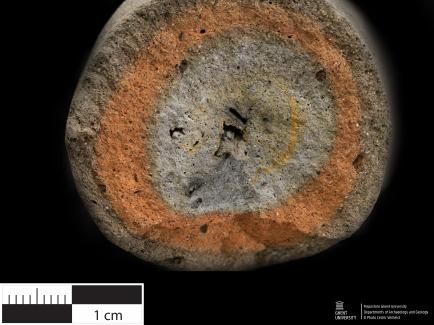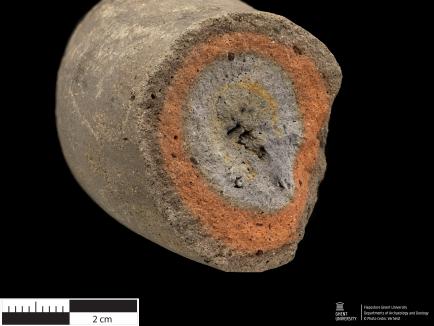Medieval - Grey reduced ware (6.GR.BE.0021)
Hand specimen pictures (macro & binocular)
Thin section pictures
Find location
- Category
- Grey reduced ware (Medieval)
- Fabric name
- Chronology
- Medieval > Late Medieval > 1250-1300
- Dating method(-s)
- typology
- Potters' mark
- No
- Additional information
- handle fragment
Find location
- Site type
- Pottery production
- Location
- Belgium; Oost-Vlaanderen; Stekene
- Site name
- Kemzeke, Verkeerswisselaar
- Excavation or Survey Team
- Archeologische Dienst Waasland (ADW)
- Additional contextual information
- KE.VW/IId/20; pit with potters waste (?)
- Surface color
- grey
- Surface texture
- Rough
- Fracture color
- grey-orange-light grey
- Inclusions (non-plastics/tempering)
- quartz (rounded and subangular), dark grey to brown oval inclusions (?), vegetal temper ?
- Matrix and voids
- large vesicles
- Diagnostic features
- Additional information
- sample KE_VW_ST6
- Flepostore inventory nr.
- ARCH1.L1.B6
- Original inventory nr.
- A0022
- Collection
- Archaeological Department, Ghent University
- Type
- Covered thin section
- Comparable thin section(s)
- Matrix
-
Reduced-Oxidised layered fabric consists of grey core, red-brown interior layer, brown exterior; black - dark brown - brown (PPL), black (XP).
Semi-heterogeneous matrix, non-calcareous with no optical activity in the reduced interior and low optical activity in the oxidised exterior. Interior (RED & OX) zones are near vintrification in some places.
- ca. 35-55% - Inclusions
-
Quartz (++; mono, poly, weathering & alteration, cf: r, medium sand, ff: sr-sa, very fine sand; bimodal), sedimentary rock detritus (+; possible quartz arenite, some slightly metamorf), chert/flint (+), muscovite mica (++; cf & ff, eq & el), feldspars (+; plagioclase, microcline, r, cf), amphibole/pyroxene (--; r, cf, weathered), O/Fe (+), semiplastics/clay pellets (+, iron-rich), organic material (--; singular burned plant inclusion coarse sand size).
The coarse fraction consists of medium sand, the fine fraction consists of very fine sand. Grains are generally rounded to subangular. Bimodal, possible sand temper. Overall the fabric is poorly sorted and very poorly orientated, single to close spaced.
- ca. 40-45% - Voids
-
Small planar voids and larger vughs, well aligned parallel to the edge, no infill. Interior layer is less porous thean exterior layer.
- ca. 5-15% - Diagnostic features
- The fabric is characterized by a semi-heterogeneous reduced-oxidised layered matrix with no to low optical activity and moderate porosity. Dominant quartz inclusions with very frequent muscovite mica, frequent sedimentary rock detritus, chert/flint, feldspars, opaques/iron oxides and iron-rich semi-plastics/clay pellets, rare amphibole/pyroxene and singular inclusion of burned plant material. Bimodal, possible sand temper. Overall very poorly sorted fabric.
- Additional information
- Similar mineralogical composition to A0020 and A0021 samples, but different firing.
- Sample type
- Pottery
- Inventory number
- 6.GR.BE.0021
- Collection
- Archaeological Department, Ghent University
- Donating institute/person
- Onroerenderfgoeddepot Waasland, Erfpunt
- Host collection
- Onroerenderfgoeddepot Waasland, Erfpunt
- Other samples available
- Yes
- Sample collection method
- Archaeological Excavation
Dewulf 1975
- Full reference
-
Dewulf M. 1975. De 14de eeuwse ceramiek van Kemzeke. Annalen van de Koninklijke Oudheidkundige Kring van het Land van Waas 78: 217-221.
Van Roeyen & Van Hove 1992
- Full reference
-
Van Roeyen J.P. & Van Hove R. 1992. Kemzeke-Verkeerswisselaar. Jaarverslag 1991. Archeologische Dienst Waasland : 23-29.
Van Roeyen 2000
- Full reference
-
Van Roeyen J.P. 2000. Een middeleeuwse pottenbakkerij aan de verkeerswisselaar te Kemzeke. d'Euzie. Tijdschrift van de Heemkundige Kring voor Groot-Stekene 19: 9-10.
Cite this page as: Flepostore - https://flepostore.ugent.be/ceramics/6-gr-be-0021
Last modified: 2024-04-29.





